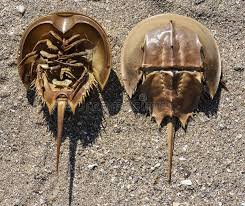TAG: GS 3: ECOLOGY AND ENVIRONMENT
THE CONTEXT: Horseshoe crabs, often referred to as “living fossils,” are facing a significant threat to their existence, prompting environmental groups to petition the U.S. government for endangered species protection.
EXPLANATION:
- This iconic marine arthropod, with a lineage dating back 450 million years, has seen a drastic decline in population, particularly in the Delaware Bay estuary, once considered a stronghold for their spawning activities.
Background:
- Horseshoe crabs, despite their ancient lineage and primitive appearance, are harmless to humans and have been a familiar sight to beachgoers along the U.S. mid-Atlantic and Gulf Coasts.
- Their populations have plummeted in recent decades, with spawning numbers in the Delaware Bay estuary down two-thirds since 1990.
- Conservation groups also note an alarming 80% reduction in egg densities over the past four decades.
Contributing Factors:
- Commercial Harvests:
- Horseshoe crabs face threats from commercial harvests for bait and biomedical use.
- The pharmaceutical industry, in particular, extracts their blue-coloured blood, which contains a clotting agent crucial for testing drugs and medical devices for bacterial endotoxins.
- In 2022, nearly 1 million horseshoe crabs were harvested for this purpose.
- Biomedical Industry Impact:
- Regulations allow the biomedical industry to extract a portion of a horseshoe crab’s blood and release it alive; however, an estimated 10-15% of harvested animals die during this process.
- The petition highlights concern that about 30% of horseshoe crabs collected for blood extraction die, contrary to official figures.
- Over-Harvesting as Bait:
- Horseshoe crabs are over-harvested as bait for commercial whelk and eel fisheries, contributing to further population decline.
- Despite the imposition of quotas, there is no evidence of recovery.
- Habitat Loss:
- The creatures face growing habitat loss due to oceanfront development, dredging, pollution, coastal erosion, and sea-level rise associated with global warming.
- Mass die-offs have been observed, with NOAA ranking the horseshoe crab’s overall vulnerability to climate change as “very high” in 2023.
Petition and Conservation Efforts:
- A coalition of 23 environmental groups, led by the Center for Biological Diversity, has petitioned the National Oceanic and Atmospheric Administration (NOAA) for an endangered species declaration.
- If granted, this designation would make it unlawful to harm or kill horseshoe crabs without a special permit.
- The petition also seeks the designation of “critical habitat” for protection, particularly during spawning season.
Horseshoe crabs:
- Horseshoe crabs are ancient marine arthropods that have been around for more than 450 million years.
- They are found in shallow waters along the Atlantic coast of North America and in the Gulf of Mexico and are known for their unique appearance, with a hard exoskeleton and a long, pointed tail.
- The crabs are represented by four extant species in the world.
- Out of the four, two species are distributed along the northeast coast of India.
- Only T gigas species of the horseshoe crab is found along Balasore coast of Odisha.
- The crab was included in the Schedule IV of the Wild (Life) Protection Act, 1972, under which, the catching and killing of a horseshoe crab is an offence.
- Horseshoe crabs play an important ecological role as a food source for migratory shorebirds and other animals, and their eggs are an important food source for fish and other marine animals.

Conclusion:
- The plight of horseshoe crabs, considered one of the world’s oldest and toughest creatures, highlights the urgent need for conservation measures.
- Human activities, including commercial harvesting for biomedical purposes and as bait, alongside habitat loss and climate change, pose a severe threat to their survival.
- The petition signals a crucial step towards acknowledging and addressing these threats to ensure the continued existence of this ancient species.
- NOAA’s review of the petition will play a pivotal role in determining the future conservation status of horseshoe crabs in the United States.

